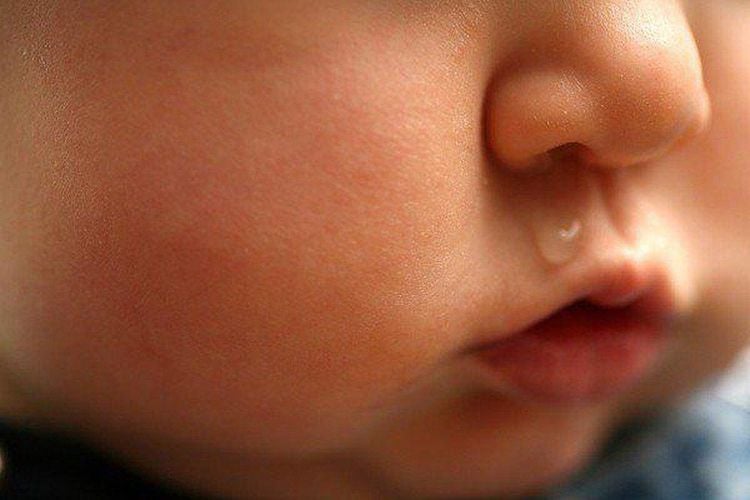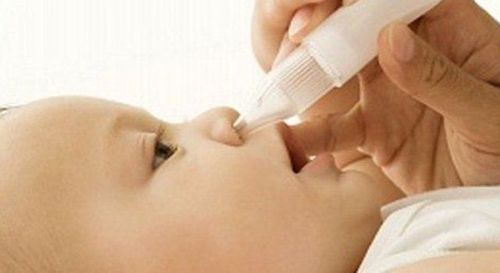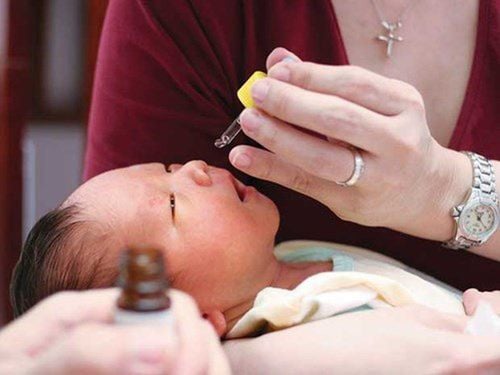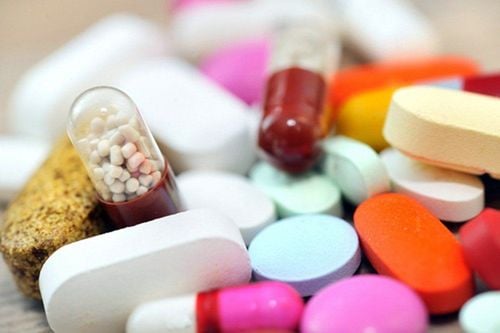This is an automatically translated article.
Weather conditions often change, environmental pollution increases are favorable conditions for the development of ear, nose and throat diseases in our country, especially with children. In addition to systemic medication, the use of topical nasal drops plays an important role in treatment. So how should parents pay attention when using antibiotic nasal drops for children?
1. What antibiotic nasal drops are there?
Antibiotic nasal drops, in addition to containing antibiotic ingredients, also have anti-inflammatory effects, reduce edema, reduce congestion. Commonly used antibiotic nasal drops include aminoside antibiotics such as Neomycin sulfate, fluoroquinolone antibiotics such as Moxifloxacine hydrochloride, Tobramycin.
2. Is it right to use antibiotic nasal drops for children to treat colds?
Babies and young children are more susceptible to colds than adults. Symptoms of a cold usually peak within 2 to 3 days and may include: sneezing, stuffy nose, runny nose, sore throat, dry cough, mucus running down your throat (postnasal drip). ), watery eyes and possibly fever. If you notice that your child is having trouble breathing or breathing quickly, is dehydrated, has a fever and cough that lasts, take your child to see a doctor for treatment, to avoid more serious complications.
MORE: Cold: When to take antibiotics?
Mucus secretion is the most common manifestation when cold virus or bacteria enter the body. First, the nose will produce clear mucus to help flush the virus from the nose and sinuses. After 2 or 3 days, the mucus may turn white, yellow, or green. Therefore, although a yellow-green runny nose is a symptom of a nasal infection, this is not a basis for determining whether antibiotic nasal drops are needed for children or not.
To know if antibiotics are needed for a child with a cold, it is necessary to determine if the cold is accompanied by a bacterial infection. If there is an infection, the doctor will prescribe antibiotic nasal drops for children to destroy and prevent local respiratory infections.
In addition, antibiotic nasal drops are often prescribed in cases of bacterial, fungal or allergic rhinitis with superinfection.
MORE: Be careful when using Naphazolin nasal drops for children

Sổ mũi là một trong các triệu chứng cảm lạnh ở trẻ nhỏ
3. Is it safe to use antibiotic nasal drops for children?
The studies have not confirmed the harmlessness of antibiotic nasal drops for children. The penetration of antibiotics through the nasal mucosa into the bloodstream, systemic absorption is possible although at very low concentrations (<1%).
For children who can't speak (usually under 2 years old) should also be cautious when using antibiotic nasal drops for children with sensitive terrain because even a small amount can cause poisoning such as cochlear toxicity. - vestibular leads to irreversible and irreversible hearing loss.
With prolonged use of antibiotic nasal drops for children as well as adults, the possibility of creating antibiotic-resistant strains of bacteria is rare but still possible. If superinfection occurs, discontinue the drug and switch to another appropriate treatment.
Using antibiotic nasal drops for children is like oral or intravenous antibiotics, they all have the potential to cause unwanted effects. Antibiotic nasal drops can cause local allergic reactions including a prickling sensation, itchy nose, swelling of the nose, redness of the nostrils, and pain along the bridge of the nose. More rarely, children may experience severe systemic allergic reactions such as edema of the skin and mucous membranes of the face, possibly even Quincke's edema. In this case, you must stop taking the drug immediately and discuss directly with the treating doctor for a reasonable adjustment.
SEE ALSO: Safe use of nasal drops to treat nasal congestion
4. How to properly use antibiotic nasal drops for children?
When using antibiotic nasal drops for children or using nasal drops in general, in order for the medicine to maximize its effectiveness, there are a few things to keep in mind as follows:
It is necessary to suck up all the stagnant mucus in the cavity. nose (can use a nasal aspirator) before giving antibiotic nasal drops to children. It is best to instill the nose when the child is in the supine or sitting position with the maximum head tilted. The bottle of nasal drops should be pointed with the tip of the dropper facing out and trying not to touch the nose and instill 1 to 2 drops at a time. The nasal cavity is connected, so please apply drops to both sides of the nose. After instillation, use your hands to clean the sides of your nose or gently inhale to allow the medicine to penetrate deeply.

Thuốc nhỏ mũi cho trẻ nhỏ cần được sử dụng đúng cách để thuốc phát huy tối đa hiệu quả
5. Besides using antibiotic nasal drops for children, what should be noted?
In addition to using antibiotic nasal drops for children when they have a cold caused by bacteria, parents should let the child rest, drink plenty of water, use a clean humidifier or cool nebulizer, use physiological saline nasal spray or drops, use a rubber suction cup to suck up mucus, inhale steam from a bowl of hot water or shower, suck on lozenges (except for children under two years old), use honey to relieve cough (children) from 1 year of age and older).
Prevention is the best way to protect children's health. Accordingly, teach children to clean their hands, cover their mouth and nose when coughing or sneezing, avoid touching their eyes, nose and mouth, and avoid close contact with smoke and people with colds or infections. upper respiratory tract.
In order to prevent unwanted complications, especially to limit the risk of extremely dangerous antibiotic resistance, parents should take their children to medical centers for examination and prescribed use. suitable antibiotic nasal drops for children.
With many years of experience in examining and treating diseases in children, now the Pediatrics Department at Vinmec International General Hospital has become one of the major health care centers, capable of examining screening and treatment of many specialized diseases in children. Therefore, if the child shows signs of rhinitis, nasal congestion, runny nose, or respiratory diseases, parents can take the child to Vinmec International General Hospital for examination and support. Support and advice from doctors and pharmacists on the effective use of antibiotics, avoiding dangerous antibiotic resistance.
Please dial HOTLINE for more information or register for an appointment HERE. Download MyVinmec app to make appointments faster and to manage your bookings easily.
Reference source: pubmed.ncbi.nlm.nih.gov












